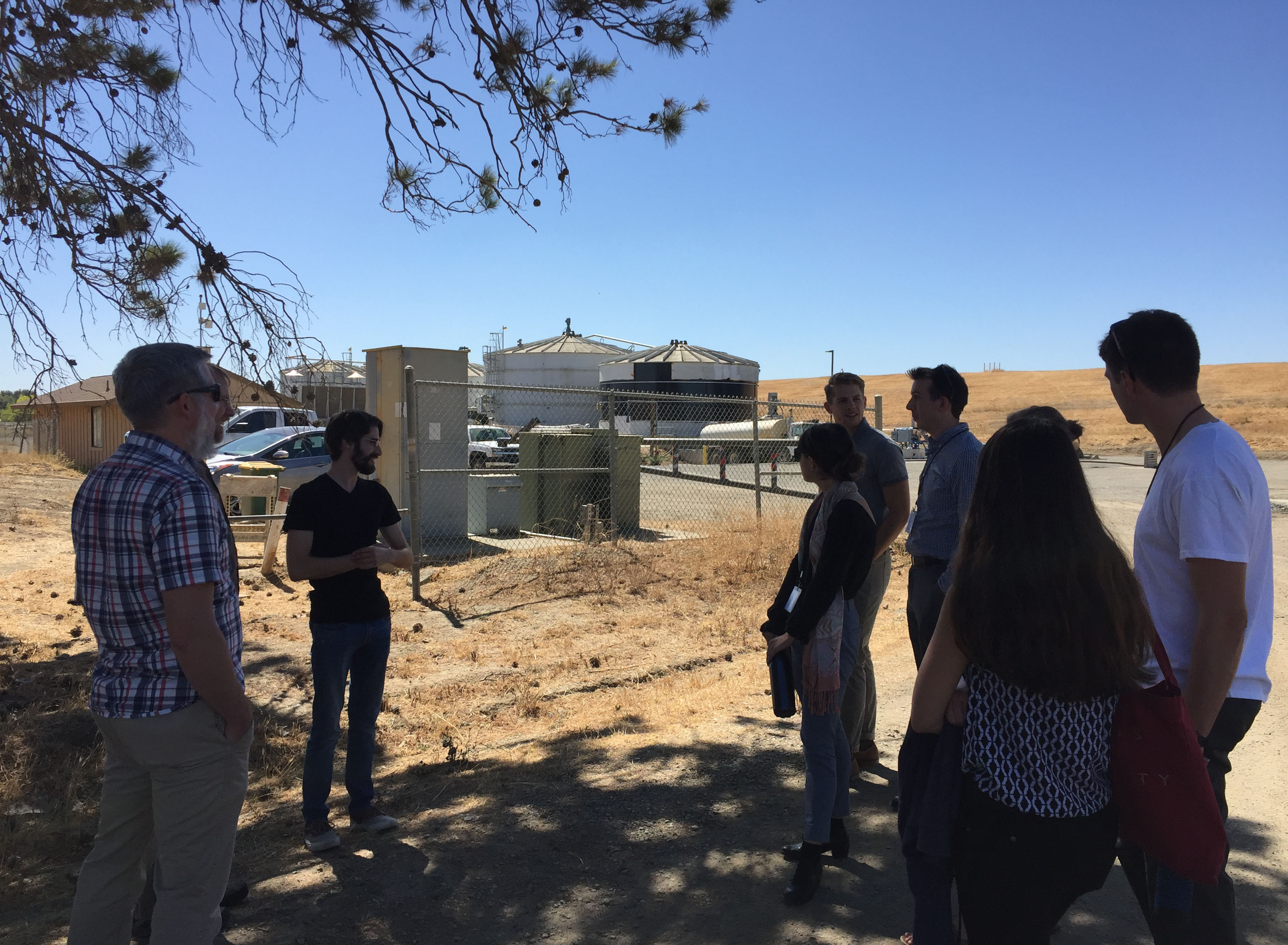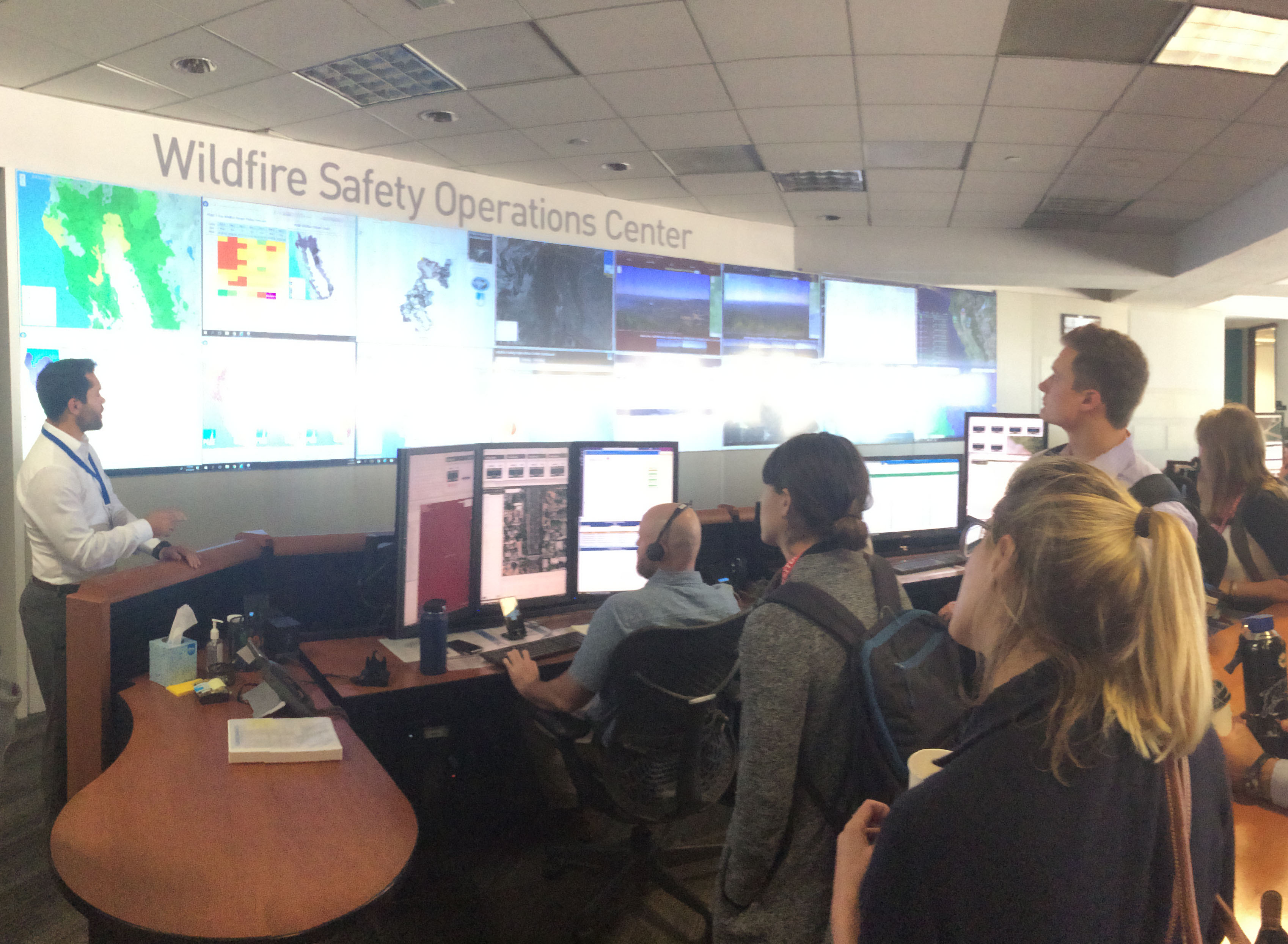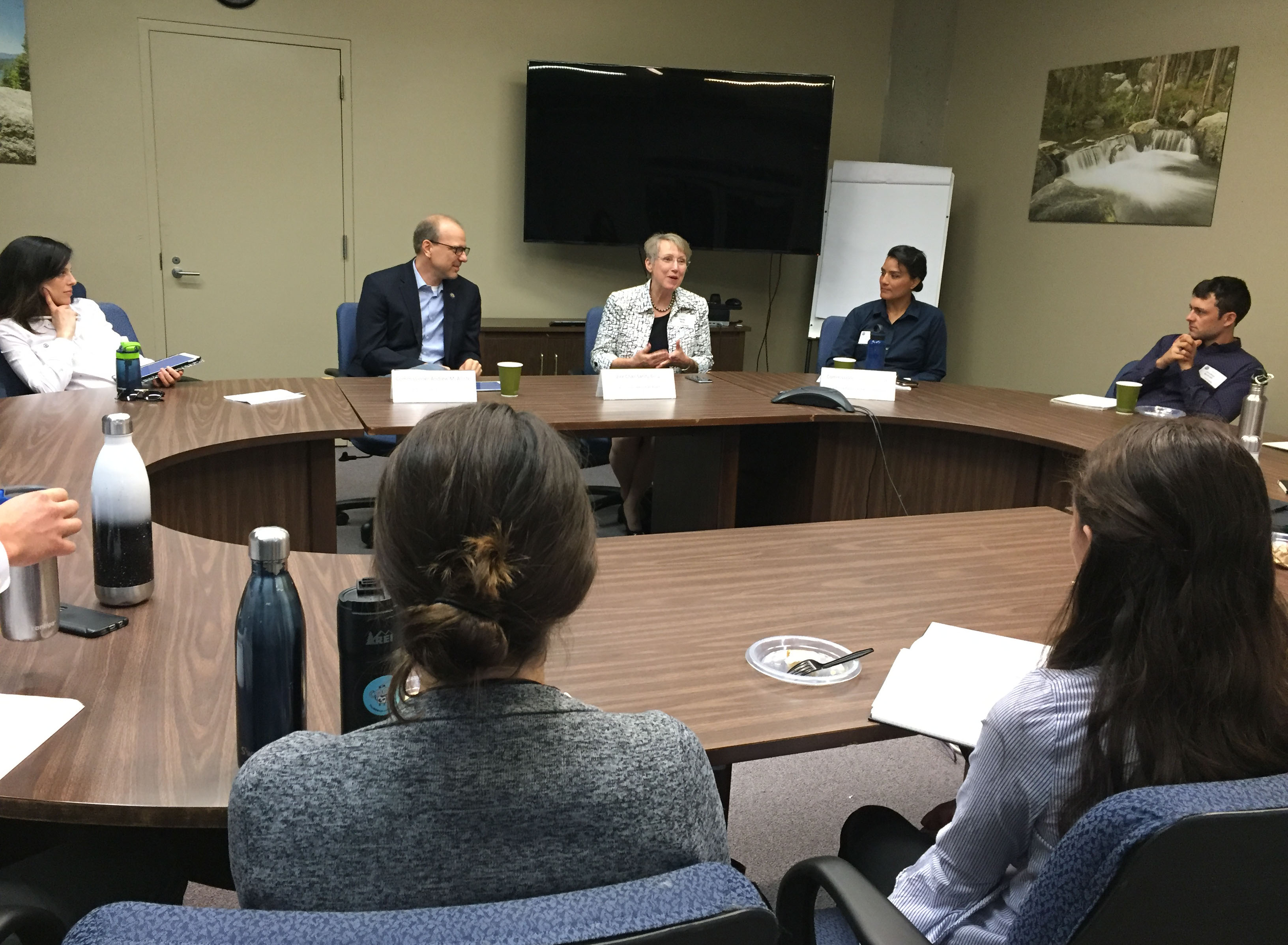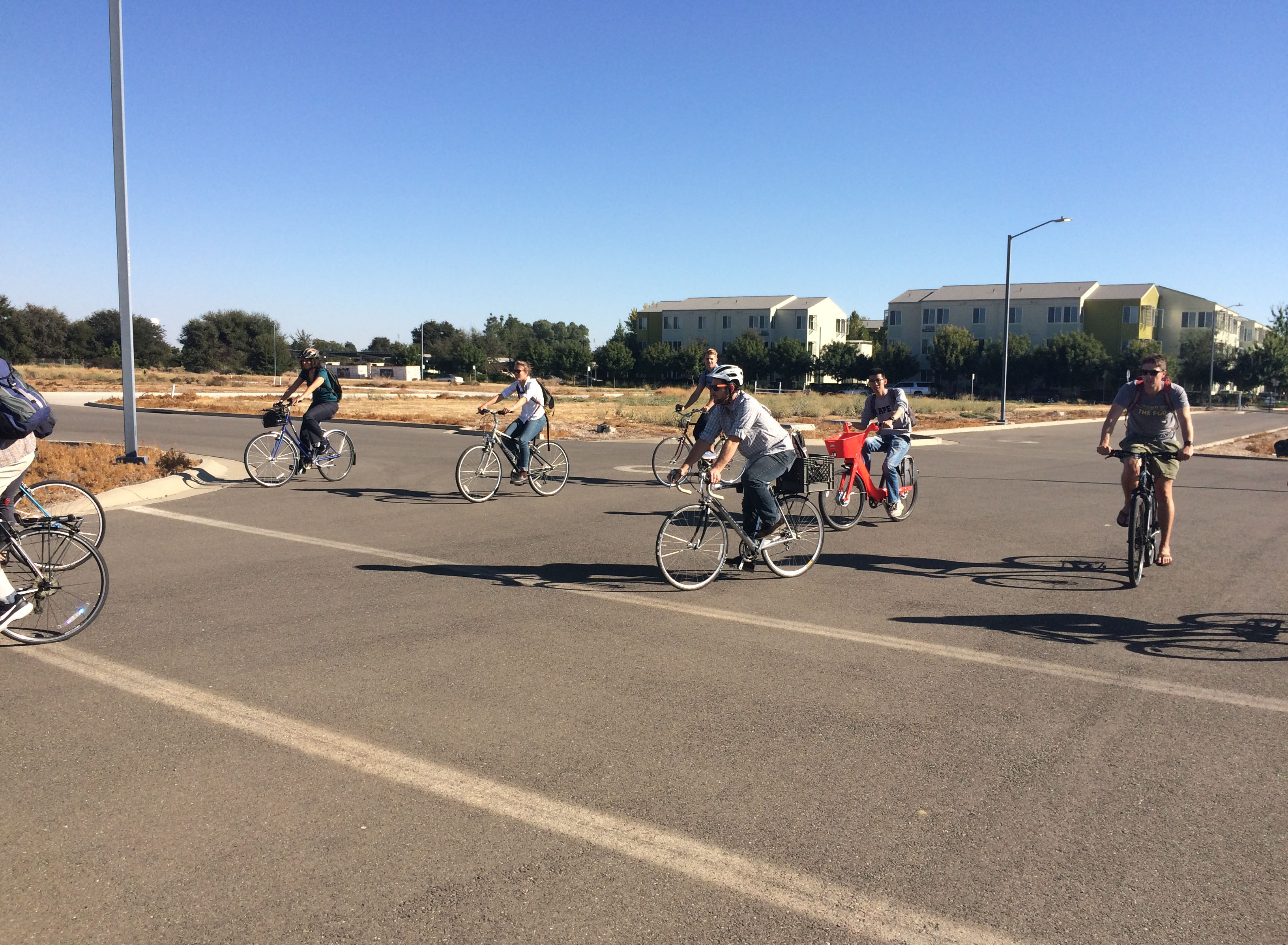In September, UC Davis welcomed the second class of Energy Graduate Group students. During their first week on campus, students participated in an orientation program–Power Trip– to learn about the wide variety of energy related research and policy work being conducted at UC Davis and in the Sacramento/Bay area through discussions with researchers and leaders from industry, government, public interest groups, and academia.

Tuesday, September 18
By Jake Highleyman
This day marked the commencement of the Power Trip 2018 orientation. Excited about the week, the new Energy Graduate Group students chatted across the table before getting to know each other more formally through a well-designed ice-breaker activity. Next, we heard from several students and faculty about the general energy landscape in California—from both the technical and economic sides. Two things became very clear: California is on the cutting edge of climate and energy policy, and that in order to understand all the overlapping stakeholders and agencies, one must have a strong appetitive for acronyms. But the presentations were only the beginning of an incredibly exciting week. After lunch with two visiting Chevron executives, we toured the local UC Davis-run anaerobic biodigester plant, which converts organic waste into methane gas and then electricity. We learned a great deal about the facility from PhD student Tyler Barzee, including its technical workings, its reliability struggles, and the economic conditions necessary for its success. The main takeaway? Nothing is ever simple!
Next, we toured the UC Davis central heating and cooling plant. For many of us, this was the highlight of the day. Josh Morejohn, the campus Energy Manager, gave a dynamic tour of the giant water boilers and chillers needed to keep campus facilities at the right temperature. We learned that the campus is planning to switch all its heating from steam to a much more efficient hot water system. It was a good example of UC Davis’ actions to save energy and decarbonize the campus. Josh also showed us the Energy Conservation Office, where staff and students are researching and implementing all sorts of creative energy-saving techniques.
To top off a tremendous day, we got to tour one of the premier solar photovoltaic research and development labs in the nation. Located on the outskirts of Davis, the SunPower R&D Ranch was impressive. We got to see how a cutting-edge solar company tests its latest panel technologies before bringing them to market. As the sun set over the neighboring farmland, I assumed that the rows of single-axis-tracking solar panels would follow the sun all the way to the horizon line. Instead, they smartly rotated slightly back towards the sky so that the row behind would stay out of the shadows.
The first day of orientation was a rousing success, and we are incredibly grateful to everyone who took the time to help us begin to understand the energy landscape.

Wednesday, September 19
By Meg Slattery
On Wednesday, the new Energy Graduate Group (EGG) students experienced our first taste of Bay Area traffic on the way to San Francisco, where we were joined by a few returning students and faculty members. The first half of the day took place at the Pacific Gas and Electric (PG&E) headquarters in San Francisco. PG&E is a investor-owned utility company that provides gas and electricity to roughly 16 million people in central and Northern California. We heard from a variety of personnel who spoke about topics including PG&E’s wildfire mitigation strategy, energy efficiency, demand response, the utility’s strategy surrounding disadvantaged communities, and renewable source procurement. The presentations continued through lunch, where we were joined by a few UC Davis alumni. After lunch, we took the elevator up to PG&E’s newly established Wildfire Safety Operations Center, where a team of meteorologists, engineers, and other analysts work 24/7 to assess wildfire risk based on weather data, news feeds, emergency transmissions, and other sources.
After our visit with PG&E, we walked to the offices of the Natural Resources Defense Council (NRDC), an environmental advocacy nonprofit. At NRDC, we had the opportunity to speak with Ralph Cavanaugh, Senior Attorney and Co-Director of the Energy Program at NRDC (not to mention Chair of the Energy and Efficiency Institute’s Board!), as well as Colin Murphy, a policy advocate at NextGen Policy. We learned a great deal listening to their insights on recent energy-related California legislation, particularly SB 100 (100% carbon free energy by 2045), SB 901 (wildfire prevention and response), and SB 237 (direct access). These conversations proved valuable over the next few days, as we were exposed to the perspectives of various industry stakeholders who are impacted by these energy policies in different ways.
A big thanks to everyone who took the time to meet with us at both locations and/or facilitate our visits!

Thursday, September 19
By Greg Miller
On Thursday, our group made the short commute into Sacramento, the state’s capitol, to meet with the public servants who are leading the state’s energy transition within government agencies, public utilities, and independent system operators. In a breakfast roundtable discussion, new and returning EGG students sat down with Commissioner Andrew McAllister of the Energy Commission, Vice Chair Sandy Berg of the Air Resources Board, and Commissioner Martha Guzman Aceves of the Public Utilities Commission. In addition to learning about the role of each agency in policymaking and regulation, the speakers shared their perspectives on key aspects of becoming future energy leaders: developing an underlying disciplinary rigor and a broad and diverse perspective, and the ability to understand and avoid any unintended or regressive outcomes during energy transitions.
We then toured the state capitol building, not only learning about the history of the state, but also gaining a deeper understanding of how state legislation is formulated and passed. At the time of our tour, several important energy-related bills had been signed by the Governor, such as SB100 (the new 100% carbon-free energy target), while others had passed the legislature and were awaiting signature by the end of the month, such as SB901 (the wildfire liability bill).
After a picnic lunch on the capitol lawn, we headed to the headquarters of the Sacramento Municipal Utility District, or SMUD, which is one of the leading publicly-owned utilities in the country. There, we met with Paul Lau, their Chief Grid Strategy and Operations Officer (and Energy and Efficiency Institute board member), as well as members of SMUD’s Energy R&D department, who are leading the charge toward the adoption of innovative energy technologies and programs.
Our afternoon wrapped up in Folsom, where the California Independent System Operator (CAISO) manages the grid’s reliability by acting as the “air traffic controller” of generators, transmission operators, and the markets that link them together. We got to observe the control room, with its wall of screens displaying everything from the real-time grid frequency and forecasted load curves to the Weather Channel and wildfire locations. We dove deep with a discussion of frequency regulation, reactive power, and the formula, called “Area Control Error,” which serves as one of the main inputs into the real-time management of grid stability.
We finished the day with a better idea of the policy opportunities for energy transition, a handful of business cards for future internship opportunities, and an appreciation of the proximity of these opportunities to our new home in Davis.

Friday, September 20
By Claire Sugihara
After hearing from some of the most prominent energy leaders in Sacramento and the San Francisco Bay Area, we returned to Davis on Friday to learn more about the many energy-related programs and initiatives both in and around the UC Davis campus. This began with a tour of the Western Cooling Efficiency Center (WCEC), where we learned about some of the many innovative technologies they test and develop such as indirect evaporative cooling, aerosolized sealant for building leaks, and improved efficiency measures for cow cooling.
From there we traveled to the California Lighting Technology Center (CLTC), where Dr. Michael Siminovitch showed us the facilities and learned about their work with circadian lighting for hospitals to improve the quality of life for both nurses and patients. This tour was particularly interesting because of all the innovations in lighting technologies that are often overlooked but are so important to our overall wellbeing.
After a quick break for lunch, we heard from some of the researchers who we will be working with daily. We heard presentations from representatives of the Plug-in Hybrid and Electric Vehicle (PH&EV) Research Center, the Center for Water-Energy Efficiency (CWEE), the Food-Water-Energy Nexus research program, and the Davis Energy Economics Program (DEEP), each of whom presented on some of the current research that students, researchers, and faculty are doing.
Next, we biked to Village Homes, a unique Davis subdivision built to limit impacts on energy and natural resources. Here we learned from Professor Steve Wheeler about the sustainable building practices of these homes, such as orientation, natural drainage systems, narrow street width, and edible landscaping, all of which help to reduce the environmental impacts of the development. From there, we ended the day with a celebratory dinner at Muir Commons where incoming EGG students were able to meet with continuing students, faculty, and staff.
It was exciting to learn about all the innovation happening right here in Davis, and how the work we are doing can have such a large impact on our energy systems. Overall, the experiences and connections we gained during the week will allow us to strengthen the increasingly important partnerships between the world of academics, government, businesses, and nonprofits. Thank you to all of those who worked to organize this amazing event and to everyone who took the time to share their expertise with us!
Student Memories
“Power Trip was a great way to focus and ground my academic interests in the practical realities and pressing challenges of our energy system, as communicated by the industry and policy experts who are leading this transition.”
“Power Trip opened my eyes to the complex and exciting energy landscape in California. Because I can now place my academic coursework and research directly within a larger context, I feel much more energized to begin my degree.”
“It is fantastic and I highly recommend any incoming student to come and join this event.”
“The Power Trip allows for a unique opportunity not only to gain exposure to a wide array of potential career fields, but it also provides networking opportunities and discussions with leaders in these fields while simultaneously bonding with your fellow EGG students!”
“Power Trip was an engaging, helpful first exposure to the energy landscape of California. By the end, I felt like I had a good understanding of the current challenges and opportunities in energy generally, but particularly those that are unique to California. I now have a better idea of what a career in the energy field could actually look like, and it immediately brought our cohort together, which has been a huge plus while navigating a new city and adapting to being back in school.”

